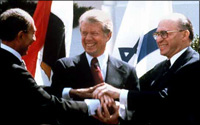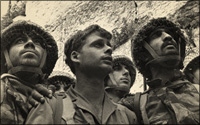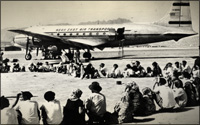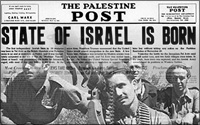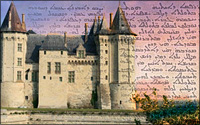 The situation of the Jewish People in France and Western Europe during the time of the First Crusade rapidly deteriorated. It set a pattern that would continue for the next few hundred years: As religious fanaticism or extremism among Catholic Europe increased the situation of the Jews deteriorated. As the Church weakened or as periods of relative liberalism occurred in the Church inWestern Europethe Jewish situation improved.
The situation of the Jewish People in France and Western Europe during the time of the First Crusade rapidly deteriorated. It set a pattern that would continue for the next few hundred years: As religious fanaticism or extremism among Catholic Europe increased the situation of the Jews deteriorated. As the Church weakened or as periods of relative liberalism occurred in the Church inWestern Europethe Jewish situation improved.
The First Crusade and its success in conqueringJerusalemandPalestinewas also the Church’s undoing. Having once accomplished what it set out to accomplish, and yet not able to achieve the spiritual, moral, and economic betterment ofEurope, it lost a great deal of standing in the minds and hearts of the people. Nachmanides said in his famous debate with the Christians in 1267, “Woe to a world that looks like this after the Messiah has come.”
In all religious undertakings, a great deal of legend, mystery, and mythology go along with it. Part of the promise that the Church made, even though no official Churchmen necessarily spoke the promise, was that when the Church would regain Jerusalem and Palestine the Second Coming of Jesus would follow and the world would settle down to true peace and prosperity; the Kingdom of Heaven would arrive. There were people throughout Christian Europe that sold their properties in anticipation of this. Utopia was around the corner.
Anyone who promises Utopia but does not deliver it creates a strong reaction of bitterness and frustration. Therefore, the very success of the First Crusade was its undoing. Instead of makingJerusalemthe City ofPeace, various Christian factions warred with each other. They set up different holy places. At one time there were as many as six places that were the “Church of the Holy Sepulcher.” Everyone claimed they had the right tomb.
Instead of having a united Christianity, the success fractured the many elements within the Church and accentuated the differences between the kingdoms of the Crusaders. Out of the triumph came the defeat.
It is hard to express how great the wave of disappointment was. Therefore, in retrospect, the First Crusade should be seen as the high watermark of the Church. From the year 1100 onward, the Church began its steady and irreversible decline… that continues in our times as well. Disappointment with the Church led to the Renaissance, the Reformation, the Modern Era, Secularism and all the problems that face Western man. After the Fist Crusade, the Church was no longer thought of as the central unifying agent of Western civilization, as the hope of mankind.
Increased Pressure to Convert
Regarding the Jews, the initial triumph of the First Crusade brought about a strong pressure to convert. The Church felt that if it could take Jerusalem away from the Muslims, and in essence rule the entire civilized world, it was reprehensible that in its midst there were about a million and a half people that practiced an anti-Christian religion.
The Church never identified Paganism as anti-Christian, but pre-Christian. The Church, in all its missionary activities, never had a truly negative attitude toward the natives inNew GuineaorSouth Americaor anywhere that Paganism was practiced. It felt the message of Christianity had not arrived there yet.
However, as articulated in the sermon of Peter the Hermit and others at the time of the First Crusade, the Jews were even worse than the Muslims, because the Muslims never really had a chance to accept Christianity. Jesus was Jewish, and Christianity was preached to the Jews, but the Jews rejected it. How could the Church afford to tolerate in their midst such a large Jewish population?
Consequently, from the beginning of the First Crusade, about 1100, until the Protestant Reformation, a period covering more than 400 years, the Church made a concerted effort to convert a large number of Jews.
Methods Used to Convert
The methods they employed included bribery, coercion and kidnapping. Rabbeinu Tam wrote that there were children from his community who were kidnapped and raised as non-Jews. Then later in life they discovered that they were Jewish. Did they need to be converted? Rabbeinu Tam says these were not isolated incidents.
We have the problem in our time where thousands of Jewish children were taken to Catholic homes and monasteries during the Holocaust. After the war, the Church refused to give them up. The Cardinal of Paris after the war, Jean-Marie Lustiger, was a Jewish boy whose mother had been taken toAuschwitz. He was raised by Catholics and considered himself a Jew. This was not uncommon in the Middle Ages.
Conversion occurred not only as an isolated instance, but generally throughout Jewish Europe and even in the greatest families. The famous Rabbeinu Gershom had a son who converted. Rabbeinu Tam quotes some of the Baalei Tosafos whose children and grandchildren converted to Christianity.
There is the famous legend of Rabbi Amnon, the author of Nisaneh Tokef prayer said at the climax of the prayers on the High Holidays. Before Rosh Hashanah he was invited by the bishop and noblemen of the town to convert. He told them they should give him three days to think it over. Then he regretted that he had even given them the indication that it was a possibility. Subsequently, he refused their invitation outright and in response they cut off his arms and legs. Bleeding to death, he was taken to the synagogue and uttered the famous prayer, Nisanah Tokef.
Whether the legend is absolutely accurate or not makes no difference. The point is that it was possible to call in the rabbi of the town and tell him we want you to convert. It was also possible for the rabbi to say he will think it over. That is an indication of the pressure of the times.
The Baalei Tosafos
Upon the death of Rashi, at the end of the First Crusade, there arose inFrancethe school of the Baalei Tosafos. They were called this because their commentary on the Talmud became known as Tosafos (“Additions”).
They spanned several generations and consisted primarily of Rashi’s children, grandchildren and his descendants. In short, they are the fathers of Ashkenazic Jewry in the sense that its customs, mindset and worldview — including its stubbornness, and its view toward the outside world — are all rooted in the customs, mindset and worldview of the Baalei Tosafos from the 11th and 12th centuries. They took a radically different direction in many ways than Spanish Jewry and it has remained part and parcel of the tradition.
Rashi had only daughters. Rashi’s oldest daughter, Yocheved, married Rabbeinu Meir ben Shmuel. Rabbeinu Meir was blessed with three great sons. Some say he had a fourth, one born after the death of Rashi and was named for him, Rabbeinu Shlomo.
One of Rabbeinu Meir’s sons was Rabbeinu Shmuel ben Meir, known by his acronym, the Rashbam. He learned with his grandfather, Rashi, and was in his early twenties when the latter died. The Rashbam wrote a commentary to all 24 books of the Bible. Only his commentary to the Five Books of Moses remains today, however. Anyone who studies it will realize that the Rashbam did not have the gift of brevity like his grandfather. Similarly, he wrote a commentary to the entire Talmud, but we have only those sections that he wrote to fill in the commentary to Rashi which had not been completed.
The Rashbam was a very wealthy man, making his money in the sheep and goat business. They lived off the milk of the goats and wool of the sheep. The method of support for the academies at that time was that the rabbis, who were men of wealth, contributed everything that was needed. The existence of an academy did not depend on public collecting as it does today. The Rashbam, therefore, not only led his academy but supported it financially.
Originally, the name Tosafos meant an “addition” to Rashi. The Rashbam’s academy eventually developed in a way, however, that the Tosafos super-commentary evolved as additions not only to Rashi but to the Talmud as well.
The second notable grandson of Rashi, brother of the Rashbam, was Rabbeinu Yitzchak ben Meir (“Rivam”). He was also a great scholar and died before he was 30.
Rabbeinu Tam
The third grandson of Rashi was Rabbeinu Yaakov, known as Rabbeinu Tam, and is the most famous of the brothers. He, more than anyone, put his stamp on all of Ashkenazic Jewry even until our times.
He had vast holdings of lands, vineyards, and was in the money-lending business. His main goal in life was leading French Jewry, especially in the north, in the study of Torah. He developed within Ashkenazic Jewry the tradition that everyone had to study the Talmud whether he would be a rabbi or not. Knowledge of the Torah is universal and no Jew can be without it.
Rabbeinu Tam was almost killed in the Second Crusade. On May 8, 1146 (the holiday of Shavuot), a Crusader mob came to the town of Ramerupt, dragged Rabbeinu Tam out of the synagogue and was about to crucify him – literally. Then they erected a cross and said, “If you’re the leader of the Jewish people in France, it’s no more than right that vengeance should be taken upon you for what the Jews did to our lord.”
At that very moment, a nobleman rode by. He was a client of Rabbeinu Tam’s bank, and he owed Rabbeinu Tam a great deal of money. Rabbeinu Tam had also done favors for him; he’d extended his loans; he’d waived interest. When the nobleman arrived, he knew that the mob was not going to be satisfied with anything less than Rabbeinu Tam’s death.
Then the nobleman hit upon a brilliant idea. “If you kill him, that’s just killing another Jew!” he told the crusaders. “Give him to me! I will convert him to Christianity. If after two days, he still refuses, I will bring him back to you.”
The mob thought about it and agreed. They gave Rabbeinu Tam over to the nobleman, and as soon as the two of them were away from the crowd, the nobleman to Rabbeinu Tam to escape. He got his family and left behind his castle, the businesses, and their wealth and property. He went back toTroyes, to Rashi’s town, and started from the beginning, all over again.
The Second Crusade
In the 1140s the second Crusade began. It was designed to strengthen the conquest of the First Crusade, but it wasn’t successful. As a result, it started a new wave of anti-Semitism and pogroms in France, Germany and the Rhineland.
Many of the Baalei Tosafos, the students of Rabbeinu Tam, moved from France to England with the Norman conquest. The generation after the Norman conquest, in the early 1100s, the Jews were inEnglandalready. These were French Jews, but the government in England was French, the king was a Frenchman and many of the people spoke French. They were escaping the anti-Semitism ofFranceto what was essentially a French colony.
We find that throughout Jewish history. When the Jews escaped throughSpainthey went to a Spanish colony: the Spanish Netherlands,Holland. When they escaped from portions of Germany, they went to Bohemia, Czechoslovakia, Silesia, which were German colonies where other Germans lived. It still had the surroundings of the places and language they knew but the virus of anti-Semitism had not yet arrived.
It would arrive, of course… in all those places, including England. But at this stage in history, England was a place of refug

